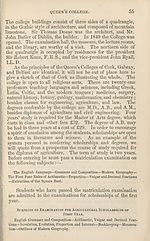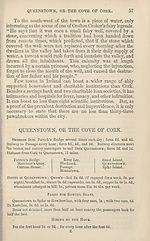Download files
Complete book:
Individual page:
Thumbnail gallery: Grid view | List view

56
CORK.
Couese of Study foe the Diploma of Ageicultuee.
First Fear.—Natural Philosophy—Chemistry—Natural History—The Theory
of Agriculture.
Second Year.— Geology and Mineralogy — History and Diseases of Farm
Animals, and Practical Veterinary Surgery, etc.—Land Surveying—Practice of
Agriculture.
The students are compelled to lodge in licensed boarding
houses, which are under the inspection of “Deans of Resi¬
dences.” There are three Deans, one an Episcopalian, one a
Presbyterian, and one a Roman Catholic.
The District Lunatic Asylum is calculated to contain 530
classified patients. It is in the Gothic style of architecture,
consisting of three buildings.
The Church of the Holy Trinity is a Gothic building,
chiefly interesting from it having been founded by the late
Theobald Mathew, the apostle of temperance. The stained
glass window which it contains was purchased with the fund
raised in Cork for the O’Connell monument. Father Mathew
received the rudiments of his education at Kilkenny, thence he
proceeded to Maynooth, and in Dublin took orders. In Cork
he commenced his labours, and also his career as the preacher
of temperance. His brother, a distiller, supplied him with
funds, but was at length brought to bankruptcy. Government
settled upon him an annuity of £300, in consideration of his
exertions as a moral reformer.
The Corn Exchange is a spacious erection, containing a
Northern Hall seventy-five feet square, by forty-five feet high;
and a Fine Arts Hall, of much larger dimensions. In this
building was held the National Exhibition of 1852.
' The Union Workhouse, the largest in the country, was
opened for paupers in 1840. The building consists of a centre
and two wings, with workshops, schools, and hospitals. The
inmates work at tailoring, weaving, and other trades. A large
corn-mill is attached, which is worked by the paupers.
The New Cemetery is about a mile distant from town. It
was formerly the Botanic Garden, and was converted into a
cemetery by Father Mathew in 1826. The ground is well
laid out, and neatly planted, after the style of the famous Pere
la Chaise, near Paris. Among the finer specimens of sepulchral
architecture which it contains, is a sarcophagus of Portland
stone, surmounted by a figure of an angel, by Hogan, a native
of Cork, in white Italian marble.
CORK.
Couese of Study foe the Diploma of Ageicultuee.
First Fear.—Natural Philosophy—Chemistry—Natural History—The Theory
of Agriculture.
Second Year.— Geology and Mineralogy — History and Diseases of Farm
Animals, and Practical Veterinary Surgery, etc.—Land Surveying—Practice of
Agriculture.
The students are compelled to lodge in licensed boarding
houses, which are under the inspection of “Deans of Resi¬
dences.” There are three Deans, one an Episcopalian, one a
Presbyterian, and one a Roman Catholic.
The District Lunatic Asylum is calculated to contain 530
classified patients. It is in the Gothic style of architecture,
consisting of three buildings.
The Church of the Holy Trinity is a Gothic building,
chiefly interesting from it having been founded by the late
Theobald Mathew, the apostle of temperance. The stained
glass window which it contains was purchased with the fund
raised in Cork for the O’Connell monument. Father Mathew
received the rudiments of his education at Kilkenny, thence he
proceeded to Maynooth, and in Dublin took orders. In Cork
he commenced his labours, and also his career as the preacher
of temperance. His brother, a distiller, supplied him with
funds, but was at length brought to bankruptcy. Government
settled upon him an annuity of £300, in consideration of his
exertions as a moral reformer.
The Corn Exchange is a spacious erection, containing a
Northern Hall seventy-five feet square, by forty-five feet high;
and a Fine Arts Hall, of much larger dimensions. In this
building was held the National Exhibition of 1852.
' The Union Workhouse, the largest in the country, was
opened for paupers in 1840. The building consists of a centre
and two wings, with workshops, schools, and hospitals. The
inmates work at tailoring, weaving, and other trades. A large
corn-mill is attached, which is worked by the paupers.
The New Cemetery is about a mile distant from town. It
was formerly the Botanic Garden, and was converted into a
cemetery by Father Mathew in 1826. The ground is well
laid out, and neatly planted, after the style of the famous Pere
la Chaise, near Paris. Among the finer specimens of sepulchral
architecture which it contains, is a sarcophagus of Portland
stone, surmounted by a figure of an angel, by Hogan, a native
of Cork, in white Italian marble.
Set display mode to:
![]() Universal Viewer |
Universal Viewer | ![]() Mirador |
Large image | Transcription
Mirador |
Large image | Transcription
| Antiquarian books of Scotland > Ireland/Irish > Black's guide to Killarney and the south of Ireland > (68) |
|---|
| Permanent URL | https://digital.nls.uk/118861484 |
|---|
| Description | Thousands of printed books from the Antiquarian Books of Scotland collection which dates from 1641 to the 1980s. The collection consists of 14,800 books which were published in Scotland or have a Scottish connection, e.g. through the author, printer or owner. Subjects covered include sport, education, diseases, adventure, occupations, Jacobites, politics and religion. Among the 29 languages represented are English, Gaelic, Italian, French, Russian and Swedish. |
|---|

